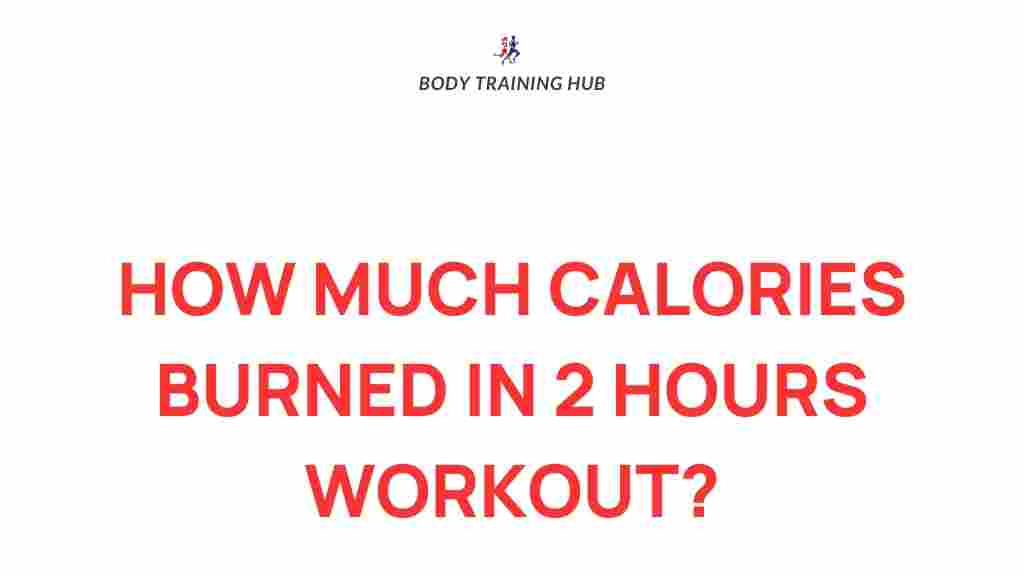Unveiling the Mystery: Calories Burned During a 2-Hour Workout
Understanding the calories burned during a workout is essential for anyone pursuing fitness, health, and effective weight loss. Whether you’re a seasoned athlete or a beginner stepping into the world of exercise, knowing how many calories you can burn in a given timeframe helps you tailor your fitness routine to meet your goals. In this article, we’ll explore various factors that influence calories burned during a 2-hour workout, different types of physical activity, and provide tips for maximizing your results.
Understanding Calories and Their Importance
Calories are a unit of energy that our bodies use to function. When you engage in physical activity, your body burns calories to fuel your movements. A basic understanding of how calories burned relates to exercise can propel you towards achieving your health and fitness goals.
- To lose weight, you need to burn more calories than you consume.
- Regular exercise boosts your metabolism, making it easier to manage your weight.
- Understanding your caloric needs can help you make informed dietary choices.
Factors Influencing Calories Burned During a Workout
The number of calories burned during a workout can vary significantly based on several factors:
- Body Weight: Heavier individuals tend to burn more calories than lighter individuals during the same activity.
- Workout Intensity: High-intensity exercise typically results in more calories burned compared to low-intensity activities.
- Duration: Longer workouts naturally lead to more calories burned.
- Type of Activity: Different workouts have varying caloric burn rates (e.g., running vs. yoga).
- Metabolic Rate: Your individual metabolism plays a crucial role in how efficiently your body burns calories.
Estimating Calories Burned in a 2-Hour Workout
Let’s look at some common workouts and their approximate calories burned for a 2-hour session:
| Type of Workout | Calories Burned (Approx.) |
|---|---|
| Running (6 mph) | 1,500 |
| Cycling (Moderate) | 1,200 |
| Swimming (Moderate) | 1,000 |
| Weight Lifting | 800 |
| Yoga | 400 |
These estimates can vary depending on individual factors, but they provide a general idea of how much you can expect to burn during a 2-hour workout.
Step-By-Step Guide to Maximizing Calories Burned
To make the most out of your 2-hour workout, consider the following steps:
1. Choose High-Intensity Activities
Incorporate high-intensity interval training (HIIT) or circuit training into your routine. These types of exercises can significantly boost your calories burned during and after the workout.
2. Mix Cardio and Strength Training
Combining cardio with strength training not only helps in burning more calories but also aids in building muscle, which can increase your resting metabolic rate.
3. Stay Hydrated
Proper hydration is crucial for maintaining your performance levels during a workout. Dehydration can lead to fatigue, reducing the amount of calories burned.
4. Incorporate Active Rest Periods
Instead of complete rest, try low-intensity activities like walking or dynamic stretching during breaks to keep your heart rate elevated.
5. Track Your Progress
Use fitness trackers or apps to monitor your heart rate and calories burned. This data can help you adjust your workouts for optimal results.
Common Mistakes to Avoid
To effectively burn calories, it is essential to avoid common pitfalls:
- Skipping Warm-up: Always start with a proper warm-up to prepare your body for the upcoming activity.
- Overtraining: Excessive workouts without adequate recovery can lead to injuries and burnout.
- Neglecting Nutrition: A balanced diet is vital for fueling your body and aiding recovery.
- Focusing Solely on Cardio: Strength training is equally important for building muscle and boosting metabolism.
Troubleshooting Tips for Common Issues
If you find that you’re not burning as many calories as expected, consider these troubleshooting tips:
1. Reassess Your Workout Intensity
If your workouts feel too easy, it might be time to increase the intensity by adding weights or trying more challenging exercises.
2. Vary Your Routine
Doing the same exercise repeatedly can lead to a plateau. Change up your routine every few weeks to keep your body guessing.
3. Monitor Your Diet
Losing weight is a combination of burning calories and managing your caloric intake. Ensure your diet aligns with your fitness goals.
4. Ensure Adequate Recovery
Rest days are essential for recovery and muscle growth. Overtraining can hinder your calories burned goals.
Conclusion
Understanding the calories burned during a 2-hour workout is crucial for anyone pursuing fitness and health. By considering factors such as body weight, workout intensity, and type of activity, you can tailor your fitness routine to maximize results. Remember to incorporate a mix of exercise, stay hydrated, and avoid common mistakes to achieve your weight loss goals. With the right approach, you can effectively burn calories, get fit, and enjoy a healthier lifestyle.
For more information on fitness and health, check out this resource. If you’re looking for personalized fitness plans, consider visiting this site for expert advice.
This article is in the category Cardio & Endurance and created by BodyTraining Team
